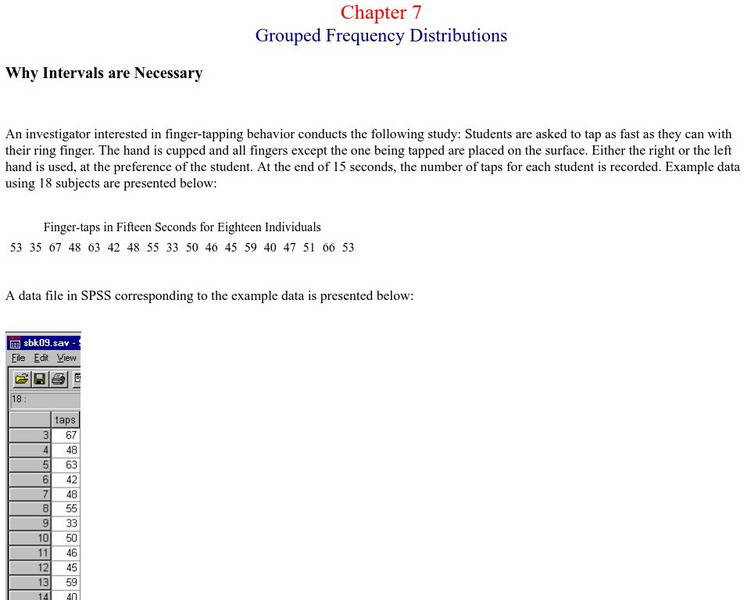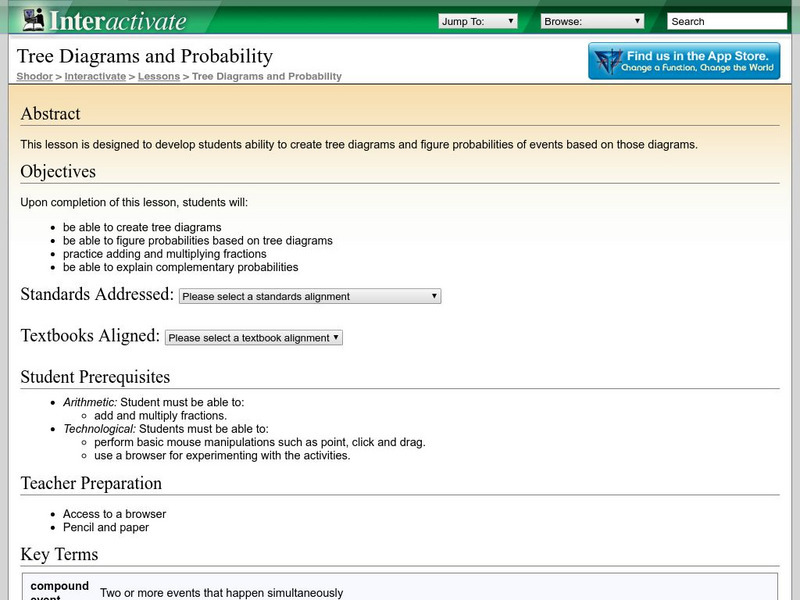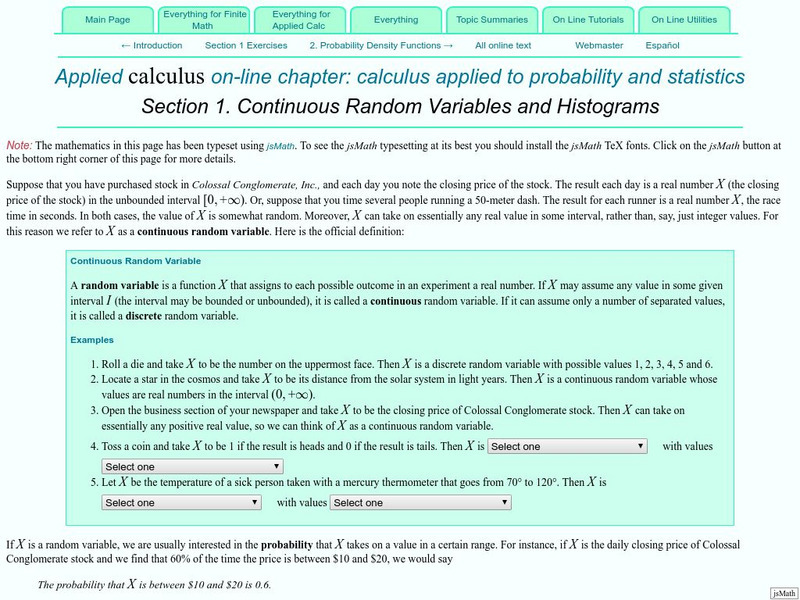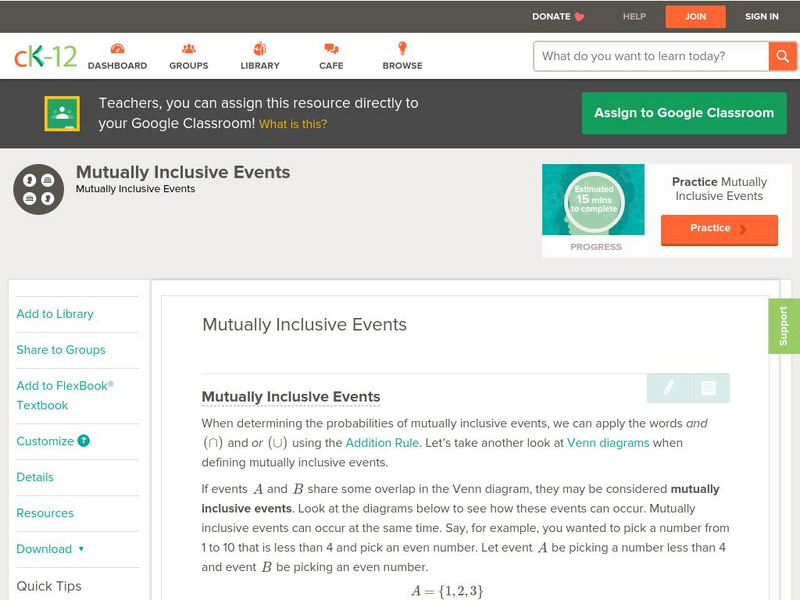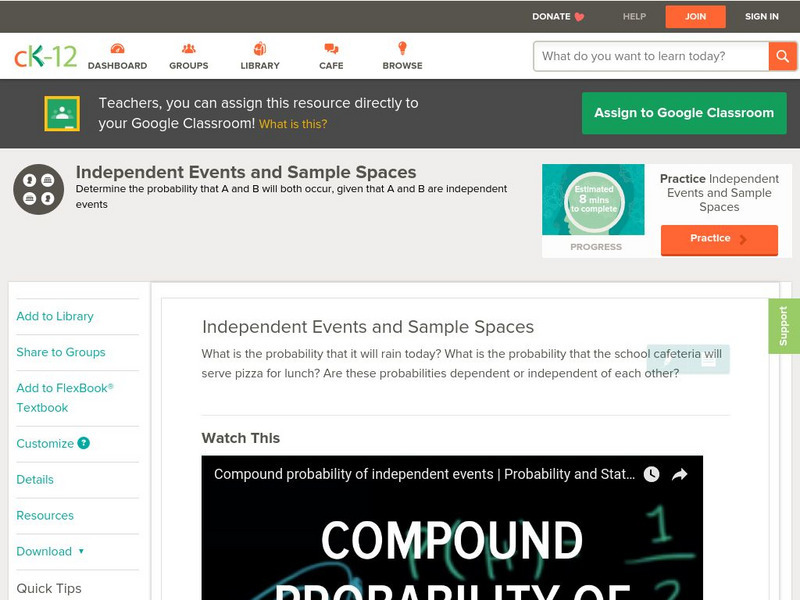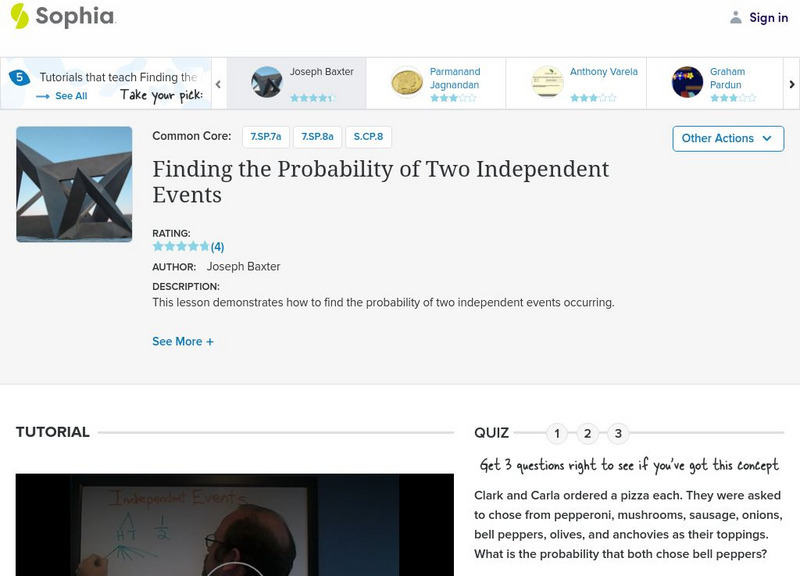Alabama Learning Exchange
Pennies, Pennies and More Pennies
Learners determine the number of pennies needed to fill a room. For this pennies lesson plan, students work in groups to determine the number of pennies needed to fill a room. They compute the probability of the head of a pin landing...
Missouri State University
Missouri State University: Introductory Statistics: Frequency Distributions
Provides a complete discussion of frequency distributions. Site is presented in notes with examples added as needed.
Missouri State University
Missouri State Univ.: Introductory Statistics: Grouped Frequency Distributions
An example is provided for the explanation of grouped frequency distributions. Graphs show how to construct histograms and overlapping bell curves, and Excel documents are discussed as being useful here.
Texas Education Agency
Texas Gateway: Introduction to Probability
This activity provides the opportunity to explore the difference between finding the probability of independent events and dependent events. It also addresses how to use a tree diagram when calculating conditional probabilities.
CK-12 Foundation
Ck 12: Interactive Algebra 1 for Ccss
This is a complete, full-year Algebra 1 course with interactivity included in every lesson. Some lessons include videos, and all include interactives and inline questions that offer instant, per-answer feedback. Every lesson also has...
Cuemath
Cuemath: Frequency Distribution Table
A comprehensive guide for learning all about frequency distribution tables with definitions, how to create a frequency distribution table, and the formulas and graphs related to frequency distributions. With solved examples and...
Shodor Education Foundation
Shodor Interactivate: Lesson: Tree Diagrams and Probability
This lesson plan helps young scholars develop tree diagrams and figure probability of events based on diagrams. Lots of resources are available to support teachers and students at this website.
Texas Instruments
Texas Instruments: Two Way Tables
This set contains statistics questions regarding two-way tables, marginal frequencies, and Simpson's paradox. The student gives an in-context interpretation to a row or column relative frequency expressed as a percent.
Texas Instruments
Texas Instruments: Simple Probability
This set contains statistics questions regarding probability as a relative frequency. The student will recognize event pairs: complementary events, mutually exclusive events, and independent events, and use them in probability calculations.
Texas Instruments
Texas Instruments: Probability as Relative Frequency
In this activity, students use simulation to justify the concept of the Law of Large Numbers. They understand that as the sample size increases, the relative frequency of which an event occurs approaches the probability of that event...
Texas Instruments
Texas Instruments: Distributions and Univariate Data
This set contains statistics questions comparing distributions of univariate data. The student is asked to note the differences between distributions regarding center, shape, spread, and existence of outliers.
Stefan Warner and Steven R. Costenoble
Finite Mathematics & Applied Calculus: Continuous Random Variables and Histograms
Students learn about random variables and histograms. Topics explored are continuous random variables, discrete random variables, probability, and frequency distributions. The tutorial investigtes the statistics concepts through class...
Stefan Warner and Steven R. Costenoble
Finite Mathematics & Applied Calculus: Uniform Distribution
Students learn about probability density functions and uniform distributions. The tutorial investigates the statistics concepts through class notes and examples. Review exercises are included.
Stefan Warner and Steven R. Costenoble
Finite Mathematics & Applied Calculus: Topic Summaries: Probability
The topic summary outlines probability. Some topics reviewed are sample space, independent events, conditional probability, and theoretical probability. The resource consists of definitions, notes, and examples.
Oswego City School District
Regents Exam Prep Center: Mutually Exclusive Events
Use this site to learn what is means for two events to be mutually exclusive. Great examples show you how to calculate the probability of such events.
Palomar Community College District
Palomar Community College: Behavioral Science Statistics: Class Intervals
A sample problem on creating intervals for a frequency distribution. The example is worked out and explained along the way.
Palomar Community College District
Behavioral Science Stats: Grouped Frequency Distribution
A sample problem that utilizes frequency distributions to find the frequency, relative frequency, intervals and cumulative relative frequencies for the given problem. The example is worked through step-by-step with a great explanation...
McGraw Hill
Glencoe Mathematics: Online Study Tools: Probability of Simple Events
This site gives a short interactive quiz which allows students to self-assess their understanding of the concept of the probability of simple events.
Mangahigh
Mangahigh: Data: Use Frequency Tables
This site provides students practice with the concept of frequency tables. Students can learn about the topic by completing an interactive tutorial. Students can then take a ten question timed test to practice the skill.
CK-12 Foundation
Ck 12: Probability: Mutually Inclusive Events Grades 9 10
[Free Registration/Login may be required to access all resource tools.] Recognize overlapping events as having one or more outcomes in common.
CK-12 Foundation
Ck 12: Statistics: Independent Events and Sample Spaces
[Free Registration/Login may be required to access all resource tools.] Covers the multiplication rule for independent events.
Annenberg Foundation
Annenberg Learner: Against All Odds: Random Variables
Video presentation on the probability of independent events, covering related topics: multiplication rule, random variable, and mean and standard deviation. [28:41]
Sophia Learning
Sophia: Finding the Probability of Two Independent Events
Determine the probability of two independent events. Assess learning with a quiz.
Texas Instruments
Texas Instruments: Using a Table to Make Conjectures
This activity is used to practice making tables for investigating a geometrical problem and to develop techniques for trying different constructions to prove a theorem.




